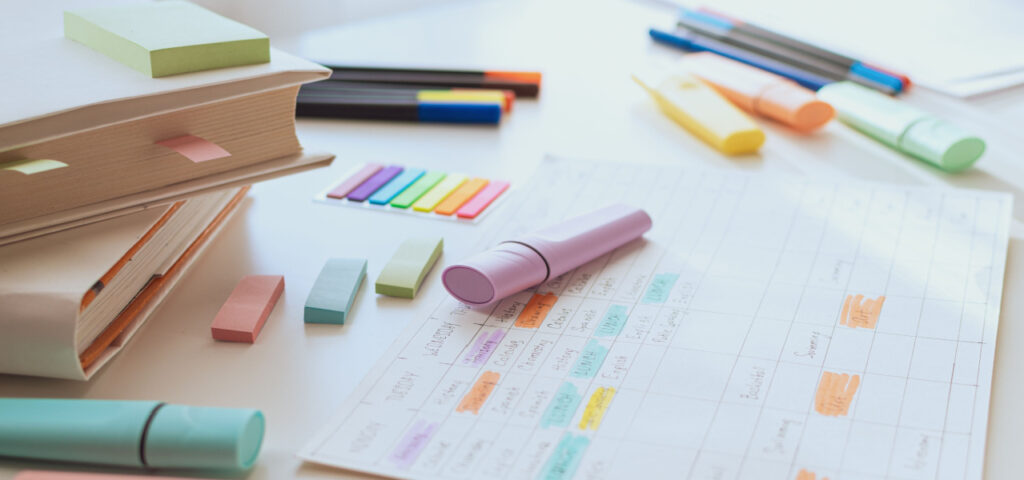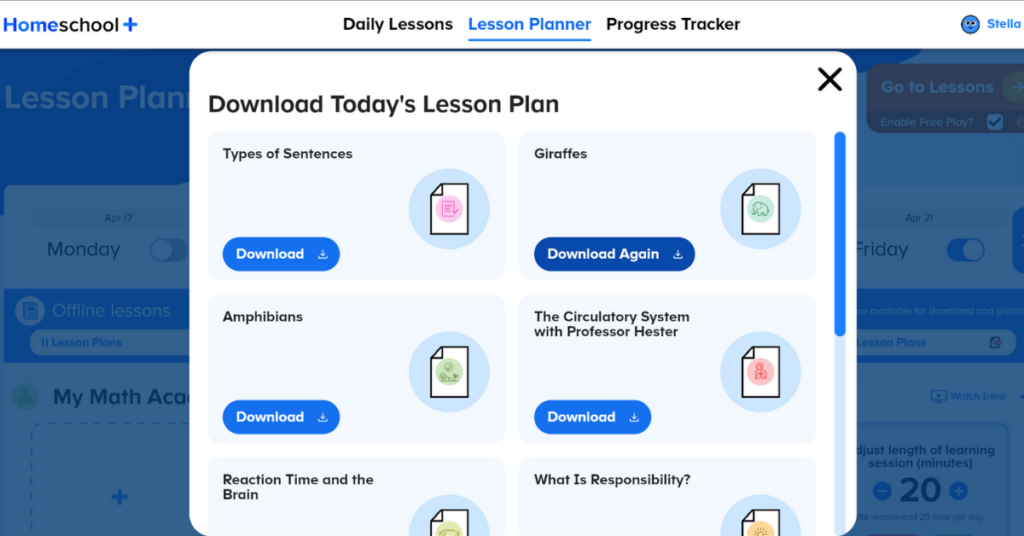
How to Create a Kindergarten Homeschool Schedule
A kindergarten homeschool schedule can help new or veteran home educators maintain a daily learning rhythm and stay on track with goals. Here are a few strategies to help you create a kindergarten homeschool schedule that works for you and your child, along with examples and tips to try.
Kindergarten Homeschool Schedule Quick Links
- What Makes an Effective Kindergarten Homeschool Schedule?
- Kindergarten Homeschool Schedule Examples
- Sticking with Your Schedule
- A Fellow Homeschooler’s Kindergarten Schedule
- How Homeschool+ Can Help Your Kindergarten Homeschool
What Makes a Kindergarten Homeschool Schedule Effective?
If you’re considering creating a schedule or readjusting the one you already have, here are a few tips to help you create a daily homeschool schedule for your kindergartener.
Make It Manageable
Many homeschoolers create a roadblock by overloading their schedule to the point of overwhelm–this can occur for children and parents. One of the most important components of building a successful homeschool schedule is to keep it manageable. Don’t feel like you need to fit every core subject into each day. Start by planning a few lessons and monitor your child’s stamina and adjust as needed.
Take Frequent Snack and Movement Breaks
If you’re noticing fatigue and irritability in yourself or your child, it’s probably time for a break. These things are often remedied with a brief rest, snack, or trip outdoors. If your child seems bored or distracted, you may need to consider a different approach to teaching certain subjects, like adding in movement, a game, or some interactive online curriculum. If swapping in new activities or a different approach improves the flow of your homeschooling, make it a permanent part of your schedule.

Build in Rhythm and Routine
Giving each day an expected flow benefits you and your child. Many young children thrive on predictability and consistency. When they know what to expect, they feel more secure and can focus better on learning and scheduled activities.
Establishing a rhythm also helps children learn how to manage their time and gives them a sense of accomplishment when they complete a task and move on to something else. A set routine is a gift for home educators, too, because the structure can help with managing your own time and schedule.
Create a Schedule Your Child Understands
Color-coding or adding illustrations to your daily schedule helps your kindergartener follow the flow of the day. Outdoor time can be labeled in green or have trees drawn on it; snacks can be labeled in blue with pictures of food; etc … Consider creating a schedule that you can velcro to the wall or clip to a string, underscoring that it’s flexible and can change a bit when needed. You can also have your student help hang up the daily schedule each morning or take it down at the end of the day, reviewing the day’s highlights as you go.
Customize It To Your Child and Lifestyle
When creating a homeschool schedule for your kindergartener, keep in mind your child’s age and developmental level, as well as your family’s unique needs and lifestyle. Make sure the activities and their duration are suitable for your child and the amount of time you have for homeschooling that day. If you have a day filled with other commitments, work lessons into your daily activities, like an audiobook in the car, counting the number of stop signs you see while driving; or talking about the habitats of the animals you see while out and about.
Keep Lessons Short
Young learners naturally have shorter attention spans. Keep lessons to around 30 minutes and provide regular breaks. When researching curricula, lesson plans, or activities, make sure they align with your student’s academic needs and present information in a variety of ways. For example, teaching a lesson through reading about a topic, drawing a picture about it, finding real-world examples, and engaging with relevant on- or offline curriculum.

Keep It Flexible and Be Patient
While routine is important, it’s also essential to be flexible. If your child is struggling with a particular activity or having a rough day, taking a break or switching to something else is okay. Homeschooling takes time and patience, both for you and your child. Try not to get too frustrated if things don’t go as planned, and remember–each day is a new opportunity to try again!
Consider Using a Lesson Planning Tool
Approach each day with a general schedule and an awareness that the schedule may need to change depending on what the day brings. Keep track of what activities or lessons need to be repeated, moved to a different day, or taught in a different manner. A Lesson Planner tool can make this easier.
Have Fun
One of the great things about homeschooling is that you can tailor your child’s education to their interests and needs. Incorporate games and movement, field trips, hands-on activities, and other fun activities into your daily schedule.
Talk with your child about the activities they most enjoy during the school day and build lessons around those elements; make up songs about letter sounds; count the birds in the yard; and find moments to connect with your child, whether it’s over the delight of mastering a new subject or watching clouds outside. Young students thrive when learning feels like play.
Try Online Resources
Sharing information with your child in a variety of ways helps them better understand and connect with it. Integrate interactive online learning with your activities to give children another approach to learning.
Finding the right online resources for your homeschool takes some research. Explore different options and take advantage of free trials so you and your student can experiment with different resources. Make a list of pros and cons for the online programs you try to hone in on the option that best suits your homeschool. Homeschool+ offers a fully customizable, engaging online curriculum, lesson plans, and progress-tracking tools.
Kindergarten Homeschool Schedule Examples
Let’s take a look at two homeschool schedules for kindergarteners. Keep in mind that each day presents lessons in 30-minute increments and add up to about one and half to two hours of subject-focused lessons.

Morning Kindergarten
Many homeschoolers recognize that their kindergartener is better equipped with patience and clarity first thing in the morning. The following sample schedule leverages that morning energy to maximize education in the first half of the day, leaving most of the afternoon open for self-guided exploration, resting, and family connection.
| Time | Activity |
| 7:00–8:00 a.m. | Breakfast, get dressed, and daily chores |
| 8:00–8:30 a.m. | Free play (adults can prep lessons) |
| 8:30–9:00 a.m. | Guided math |
| 9:00–9:30 a.m. | Language Arts |
| 9:30–10:00 a.m. | Snack and free-play |
| 10:00–10:30 a.m. | Art or science |
| 10:30–Noon | Outside play and exploration |
| Noon–1:00 p.m. | Lunch, clean up, and quiet time |
All-Day Kindergarten
Spending the day immersed in learning with your child can be a wonderful experience. If all-day kindergarten suits your child’s needs and your lifestyle, here’s an example to inspire your own all-day kindergarten homeschool schedule.
| Time | Activity |
| 7:00–8:00 a.m. | Breakfast, get dressed, and daily chores |
| 8:00–9:00 a.m. | Free play (adults can prep lessons) |
| 9:00–9:30 a.m. | Guided math |
| 9:30–10:00 a.m. | Language Arts |
| 10:00–10:30 a.m. | Snack and free-play |
| 10:30–11:00 a.m. | Hands-on science |
| 11:00–Noon | Outside play and exploration |
| Noon–12:30 p.m. | Lunch |
| 12:30–2:00 p.m. | Quiet time (adults can prep lessons and complete other tasks) |
| 2:00–2:30 p.m. | Art and music |
| 2:30–3:00 p.m. | Snack time |
| 3:00–3:30 p.m. | Free play and clean-up |
Create a Schedule and Stick With It
Creating a schedule that your kindergartener (and you) look forward to each day makes homeschooling more enjoyable. Keep your schedule very fluid in the beginning as you learn what’s working best for your family,
Committing to maintaining a schedule is just as important. Skipping the time to plan and schedule can be tempting, but it tends to create an atmosphere of unrest and chaos for all involved. Following the same (or similar) routine sets you and your kindergartner up for success each day.
When creating your schedule, start with realistic expectations. Do you or your child like to sleep in? Do you have personal work you need to complete before starting school? Take all of this into consideration before creating a daily schedule. As more days go by adhering to your schedule, the easier it will be to follow it naturally. Create a schedule that easily fits into your lifestyle, and it will eventually become a daily routine.
Hear It From a Homeschooler
Fellow homeschooler and writer, Celia Hatch, is sharing the strategies she used to create her kindergarten homeschool schedule.
Keep It Simple
As a homeschool parent myself, I found that creating a simple schedule was essential to maintaining a sense of balance. Our daily rhythm met the needs of each of my family members, while also allowing me to manage my own responsibilities.
Here are three things I considered when creating my homeschool schedule:
- Are you leaving time in the day to create a plan for the next homeschool day or to take care of your adult responsibilities?
- Does your schedule have space for flexibility and allowing your child to follow their curiosity?
- Is your routine sustainable for your family’s unique situation?
The minimalist schedule I created for our kindergarten homeschool was inspired by the Waldorf method of teaching in blocks or units. Rather than skimming the surface in science, reading, math, and art daily, we focused on one area and did a deep dive into that block each day.
For example, we would spend two weeks focusing on Aesop’s Fables, then switch our attention for two weeks to really understand a math concept, the next block might be about Birds of Prey, or gathering, polishing, and studying rocks. Each subject area was approached from different angles and with different approaches, like reading, hands-on activities, and drawing or exploring the topic in our daily lives.
In addition to our main lesson block, I utilized professionally created online education tools in our homeschool. This gave me a window to prepare lessons for the next day or to manage household tasks.
For my family, having a routine was important. By following this rhythmic schedule, we were able to establish a healthy and sustainable homeschool.
Here is a peek at our Kindergarten homeschool schedule.
| Time | Activity |
| 8:00 a.m. | Breakfast and gratitude verse |
| 8:30 a.m. | Age-appropriate chores |
| 9:00 a.m. | Main lesson block |
| 10:30 a.m. | Snack and free play |
| 11:30 a.m. | Online homeschool program |
| Noon | Lunch and outside play |
| 2:00 p.m. | Story time followed by family rest time |
How Homeschool+ Can Help Support Your Kindergartener
Not only does Homeschool+ provide kindergarteners with engaging lessons on a variety of subjects, but it also comes with tools that help home educators keep their homeschool on track. The Lesson Planner tool lets you customize each day’s plans, and the Progress Tracker lets you monitor your child’s comprehension and progress.

Your kindergartener will enjoy engaging, hands-on activities that include core subjects of study, such as math, reading, science, and social studies, as well as extracurricular activities like art, Spanish, and music. Every lessons is designed to connect with your child in a variety of ways, helping to provide multiple pathways for learning. Each subjects also includes online and offline lessons with extended learning opportunities, so you and your child can dig deeper into areas of interest.